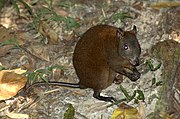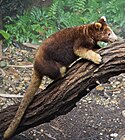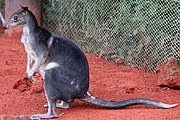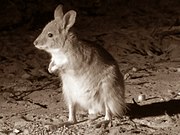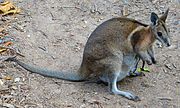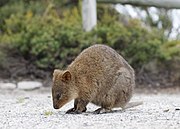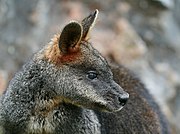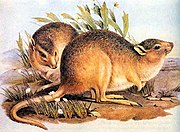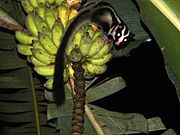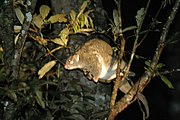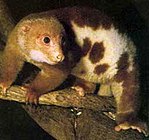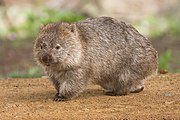
Diprotodontia is an order of Australian marsupial mammals. Members of this order are called diprotodonts. Diprotodontia is the largest order of marsupials and currently comprises 140 extant species, which are grouped into 39 genera. They are found in Australia, New Guinea, and Indonesia, in forests, shrublands, grasslands, and savannas, though some species are found in deserts and rocky areas. They come in a wide array of sizes, ranging from the Tasmanian pygmy possum, at 5 cm (2 in) plus a 6 cm (2 in) tail, to the red kangaroo, at 160 cm (63 in) plus a 120 cm (47 in) tail.
Diprotodontia is subdivided into three suborders: Macropodiformes, Phalangeriformes, and Vombatiformes. Macropodiformes has 72 species in 3 families: Hypsiprymnodontidae, Macropodidae, and Potoroidae, and includes kangaroos, wallabies, bettongs, potoroos, and rat-kangaroos. Phalangeriformes has 64 species in 6 families: Acrobatidae, Petauridae, Pseudocheiridae, Tarsipedidae, Burramyidae, and Phalangeridae, and includes cuscus and the brushtail, ringtail, and gliding possums. Vombatiformes has only four species in two families: Phascolarctidae, the koala, and Vombatidae, the wombats. The classification of species in the order is not fixed, with many recent proposals for changes made based on molecular phylogenetic analysis. Additionally, the present set of suborders was created beginning in 1997 by splitting the former suborder Phalangerida into Macropodiformes and Phalangeriformes, and further reorganizations have been proposed.
In addition to the extant species, eight species in the suborder Phalangeriformes—four in the family Macropodidae and four in Potoroidae—have been made extinct in the modern era, all between the 1880s and the 1940s after the colonization of Australia began: the broad-faced potoroo, crescent nail-tail wallaby, desert bettong, desert rat-kangaroo, eastern hare-wallaby, Lake Mackay hare-wallaby, Nullarbor dwarf bettong, and toolache wallaby. Dozens of extinct, prehistoric Diprotodont species have also been discovered, though due to ongoing research and discoveries the exact number and categorization is not fixed.
Conventions
Range maps are provided wherever possible; if a range map is not available, a description of the collective range of species in that genera is provided. Ranges are based on the International Union for Conservation of Nature (IUCN) Red List of Threatened Species unless otherwise noted. All extinct genera or species listed alongside extant species went extinct after 1500 CE, and are indicated by a dagger symbol "†".
Classification
|
The order Diprotodontia consists of 140 extant species belonging to 39 genera. This does not include hybrid species or extinct prehistoric species. Modern molecular studies indicate that the 39 genera can be grouped into 11 families; these families are grouped into the suborders Macropodiformes, Phalangeriformes, and Vombatiformes, and many are further grouped into named clades or subfamilies. In addition to the extant species, eight species in the suborder Phalangeriformes—four in the family Macropodidae and four in Potoroidae, including one extinct genus—have been made extinct in the modern era, all between the 1880s and the 1940s after the colonization of Australia began.
Suborder Macropodiformes
- Family Hypsiprymnodontidae (musky rat-kangaroo): 1 genus, 1 species
- Family Macropodidae
- Subfamily Macropodinae (kangaroos and wallabies) 12 genera, 66 species (4 extinct)
- Subfamily Sthenurinae (banded hare-wallaby) 1 genera, 1 species
- Family Potoroidae (bettongs, potoroos, and rat-kangaroos) 4 genera (1 extinct), 9 species (2 extinct)
Suborder Phalangeriformes
- Superfamily Petauroidea
- Family Acrobatidae (feather-tailed possum and feather-tailed glider): 2 genera, 2 species
- Family Petauridae (possums): 3 genera, 11 species
- Family Pseudocheiridae
- Subfamily Hemibelideinae (greater gliders): 2 genera, 2 species
- Subfamily Pseudocheirinae (ringtail possums): 3 genera, 11 species
- Subfamily Pseudochiropsinae (ringtail possums): 1 genus, 5 species
- Family Tarsipedidae (honey possum): 1 genus, 1 species
- Superfamily Phalangeroidea
- Family Burramyidae (pygmy possums): 2 genera, 5 species
- Family Phalangeridae
- Subfamily Ailuropinae (bear cuscus): 1 genus, 2 species
- Subfamily Phalangerinae (cuscus): 5 genera, 25 species
Suborder Vombatiformes
- Family Phascolarctidae (koala): 1 genus, 1 species
- Family Vombatidae (wombats): 2 genera, 3 species
Diprotodonts
The following classification is based on the taxonomy described by Mammal Species of the World (2005), with augmentation by generally accepted proposals made since using molecular phylogenetic analysis, as supported by both the IUCN and the American Society of Mammalogists.
Suborder Macropodiformes
Main article: List of macropodiformesHypsiprymnodontidae
| Name | Authority and species | Range | Size and ecology |
|---|---|---|---|
| Hypsiprymnodon (musky rat-kangaroo) |
Ramsay, 1876
One species
|
Northeastern Australia
|
Size: 20–35 cm (8–14 in) long, plus 6–13 cm (2–5 in) tail Habitats: Forest Diet: Insects, as well as worms, tuberous roots, and palm berries |
Macropodidae
| Name | Authority and species | Range | Size and ecology |
|---|---|---|---|
| Dendrolagus (tree-kangaroo) |
Müller, 1840
Fourteen species
|
New Guinea and northeastern Australia | Size range: 41 cm (16 in) long, plus 40 cm (16 in) tail (Doria's tree-kangaroo) to 81 cm (32 in) long plus 94 cm (37 in) tail (dingiso) Habitats: Forest and shrubland Diets: Leaves, flowers, and fruit, as well as ferns, soft vines, cereals, grass, bark, nuts, insects, sap, bird eggs, and young birds |
| Dorcopsis (dorcopsis) |
Schlegel & Müller, 1842
Four species
|
New Guinea | Size range: 34 cm (13 in) long, plus 27 cm (11 in) tail (brown dorcopsis) to 100 cm (39 in) long plus 40 cm (16 in) tail (black dorcopsis) Habitats: Forest Diets: Leaves, roots, grass and fruit |
| Dorcopsulus (forest wallaby) |
Matschie, 1916
Two species
|
New Guinea | Size range: 31–46 cm (12–18 in) long, plus 22–41 cm (9–16 in) tail Habitats: Forest Diets: Leaves, fruit, buds, and stems |
| Lagorchestes (hare-wallaby) |
Gould, 1841
Four species
|
Australia | Size range: 31 cm (12 in) long, plus 24 cm (9 in) tail (rufous hare-wallaby) to 49 cm (19 in) long plus 53 cm (21 in) tail (spectacled hare-wallaby) Habitats: Desert, grassland, forest, shrubland, and savanna Diets: Grass, forbs, herbs, seeds, fruit, sedges, and succulent shrubs |
| Macropus (grey kangaroo) |
Shaw, 1790
Two species
|
Southern and eastern Australia | Size range: 85–140 cm (33–55 in) long, plus 75–100 cm (30–39 in) tail Habitats: Savanna, grassland, shrubland, and forest Diets: Grass, forbs, leaves, tree bark, and shrubs |
| Notamacropus (brush wallaby) |
Dawson & Flannery, 1985
Eight species
|
Australia and southern New Guinea | Size range: 40 cm (16 in) long, plus 33 cm (13 in) tail (several) to 105 cm (41 in) long plus 75 cm (30 in) tail (red-necked wallaby) Habitats: Shrubland, grassland, savanna, and forest Diets: Grass, ferns, herbs, shrubs, bushes, and roots, as well as leaves and fruit |
| Osphranter | Shaw, 1790
Four species
|
Australia | Size range: 73 cm (29 in) long, plus 64 cm (25 in) tail (black wallaroo) to 160 cm (63 in) long plus 120 cm (47 in) tail (red kangaroo) Habitats: Desert, grassland, forest, shrubland, and savanna Diets: Grass and shrubs |
| Onychogalea (nail-tail wallaby) |
Gray, 1841
Three species
|
Scattered Australia | Size range: 37 cm (15 in) long, plus 15 cm (6 in) tail (crescent nail-tail wallaby) to 70 cm (28 in) long plus 73 cm (29 in) tail (bridled nail-tail wallaby) Habitats: Savanna, grassland, shrubland, and forest Diets: Herbs, succulents, fruit, grass, forbs, and shrubs |
| Petrogale (rock-wallaby) |
Gray, 1837
Sixteen species
|
Australia | Size range: 29 cm (11 in) long, plus 25 cm (10 in) tail (monjon) to 70 cm (28 in) long plus 70 cm (28 in) tail (allied rock-wallaby) Habitats: Desert, grassland, forest, shrubland, rocky areas, and savanna Diets: Grass and leaves, as well as shrubs, forbs, fungi, sedges, ferns, roots, bark, fruit, seeds and flowers |
| Setonix (quokka) |
Lesson, 1842
One species
|
Southwestern Australia
|
Size: 39–60 cm (15–24 in) long, plus 23–35 cm (9–14 in) tail Habitats: Forest, shrubland, and inland wetlands Diet: Succulents, shrubs, forbs, grasses and sedges, as well as seeds, berries, and fruit |
| Thylogale (pademelon) |
Gray, 1837
Seven species
|
New Guinea, eastern Australia, and Tasmania | Size range: 29–67 cm (11–26 in) long, plus 24–57 cm (9–22 in) tail (several) Habitats: Savanna, grassland, shrubland, and forest Diets: Grass, leaves, shoots, seeds, and fruit, as well as grass, bark, fungi, and cicadas |
| Wallabia (swamp wallaby) |
Trouessart, 1905
One species
|
Eastern Australia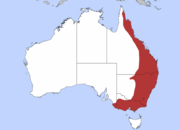
|
Size: 66–85 cm (26–33 in) long, plus 64–87 cm (25–34 in) tail Habitats: Forest and shrubland Diet: Buds, ferns, leaves, shrubs, and grasses, as well as bark and shoots from needle-leaf trees |
| Name | Authority and species | Range | Size and ecology |
|---|---|---|---|
| Lagostrophus (banded hare-wallaby) |
Thomas, 1887
One species
|
Western Australia
|
Size: 40–46 cm (16–18 in) long, plus 32–40 cm (13–16 in) tail Habitats: Shrubland Diet: Plants and fruit |
Potoroidae
| Name | Authority and species | Range | Size and ecology |
|---|---|---|---|
| Aepyprymnus (rufous rat-kangaroo) |
Garrod, 1875
One species
|
Northeastern Australia
|
Size: 37–52 cm (15–20 in) long, plus 35–40 cm (14–16 in) tail Habitats: Forest and savanna Diet: Grass, herbs, roots, tubers, and fungi, as well as carrion bones and larvae |
| Bettongia (bettong) |
Gray, 1837
Six species
|
Australia | Size range: 27–44 cm (11–17 in) long, plus 26–35 cm (10–14 in) tail (northern bettong) Habitats: Desert, forest, shrubland, and savanna Diets: Leaves, seeds, fruits, nuts, tubers, bulbs, flowers, and fungi, as well as insects, resin, marine carrion, and small invertebrates |
| Caloprymnus† (desert rat-kangaroo) |
Thomas, 1888
One species
|
Central Australia
|
Size: 25–29 cm (10–11 in) long, plus 29–38 cm (11–15 in) tail Habitats: Desert Diet: Leaves and stems, as well as insects |
| Potorous (potoroo) |
Desmarest, 1804
Four species
|
Southwestern Australia, southeastern Australia, and Tasmania | Size range: 24–42 cm (9–17 in) long, plus 19–33 cm (7–13 in) tail (several) Habitats: Shrubland, inland wetlands, and forest Diets: Fungi, insects, grass, roots, and other vegetation |
Suborder Phalangeriformes
Main article: List of phalangeriformesSuperfamily Petauroidea
Acrobatidae
| Name | Authority and species | Range | Size and ecology |
|---|---|---|---|
| Acrobates (feathertail glider) |
Desmarest, 1818
One species
|
Eastern Australia
|
Size: 6–8 cm (2–3 in) long, plus 7–8 cm (3 in) tail Habitats: Forest Diet: Honeydew and arthropods |
| Distoechurus (feather-tailed possum) |
Peters, 1874
One species
|
New Guinea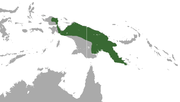
|
Size: 10–12 cm (4–5 in) long, plus 6–12 cm (2–5 in) tail Habitats: Forest Diet: Nectar, pollen, insects, and soft fruit |
Petauridae
| Name | Authority and species | Range | Size and ecology |
|---|---|---|---|
| Dactylopsila (triok) |
Gray, 1858
Four species
|
New Guinea and northeastern Australia | Size range: 17–32 cm (7–13 in) long, plus 16–40 cm (6–16 in) tail (several) Habitats: Forest Diets: Insects, fruit, and leaves |
| Gymnobelideus (Leadbeater's possum) |
McCoy, 1867
One species
|
Southern Australia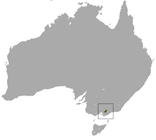
|
Size: 15–17 cm (6–7 in) long, plus 14–18 cm (6–7 in) tail Habitats: Forest Diet: Insects, spiders, and sap |
| Petaurus (wrist-winged gliders) |
Shaw, 1791
Six species
|
New Guinea and northern, eastern, and southern Australia | Size range: 12–32 cm (5–13 in) long, plus 15–48 cm (6–19 in) tail (various) Habitats: Savanna and forest Diets: Nectar, pollen, sap, gum, seeds, insects, arachnids, and small vertebrates |
Pseudocheiridae
| Name | Authority and species | Range | Size and ecology |
|---|---|---|---|
| Hemibelideus (lemuroid ringtail possum) |
Collett, 1884
One species
|
Northeastern Australia
|
Size: 30–38 cm (12–15 in) long, plus 30–35 cm (12–14 in) tail Habitats: Forest Diet: Leaves |
| Petauroides (southern greater glider) |
Thomas, 1888
One species
|
Southeastern Australia | Size: 30–48 cm (12–19 in) long, plus 45–55 cm (18–22 in) tail Habitats: Forest Diet: Eucalyptus leaves |
| Name | Authority and species | Range | Size and ecology |
|---|---|---|---|
| Petropseudes (rock-haunting ringtail possum) |
Thomas, 1923
One species
|
Northern Australia
|
Size: 33–38 cm (13–15 in) long, plus 20–27 cm (8–11 in) tail Habitats: Rocky areas Diet: Leaves, fruit, blossoms, and flowers, as well as termites |
| Pseudocheirus (ringtail possum) |
Ogilby, 1837
Two species
|
Eastern, southern, and southwestern Australia | Size range: 28–40 cm (11–16 in) long, plus 28–36 cm (11–14 in) tail (Western ringtail possum) Habitats: Savanna and forest Diets: Leaves, as well as flowers, buds, nectar, fruit, bark, and sap |
| Pseudochirulus (slender ringtail possum) |
Matschie, 1915
Eight species
|
New Guinea and northeastern Australia | Size range: 16 cm (6 in) long, plus 15 cm (6 in) tail (several) to 40 cm (16 in) long plus 47 cm (19 in) tail (Herbert River ringtail possum) Habitats: Forest Diets: Leaves, fruit, ferns, pollen, fungus, moss, and lichens |
| Name | Authority and species | Range | Size and ecology |
|---|---|---|---|
| Pseudochirops (ringtail possum) |
Matschie, 1915
Five species
|
New Guinea and northeastern Australia | Size range: 28–41 cm (11–16 in) long, plus 25–38 cm (10–15 in) tail (several) Habitats: Grassland and forest Diets: Leaves as well as fruit |
Tarsipedidae
| Name | Authority and species | Range | Size and ecology |
|---|---|---|---|
| Tarsipes (honey possum) |
Gervais & Verreaux, 1842
One species
|
Southwestern Australia
|
Size: 6–9 cm (2–4 in) long, plus 7–11 cm (3–4 in) tail Habitats: Shrubland Diet: Pollen and nectar |
Superfamily Phalangeroidea
Burramyidae
| Name | Authority and species | Range | Size and ecology |
|---|---|---|---|
| Burramys (mountain pygmy possum) |
Broom, 1895
One species
|
Southeastern Australia
|
Size: 10–12 cm (4–5 in) long, plus 13–16 cm (5–6 in) tail Habitats: Shrubland Diet: Insects, spiders, seeds, and berries |
| Cercartetus (pygmy possum) |
Gloger, 1841
Four species
|
New Guinea and northeastern and southern Australia | Size range: 5 cm (2 in) long, plus 6 cm (2 in) tail (Tasmanian pygmy possum) to 11 cm (4 in) long plus 16 cm (6 in) tail (long-tailed pygmy possum) Habitats: Shrubland and forest Diets: Nectar, pollen, invertebrates, and small lizards |
Phalangeridae
| Name | Authority and species | Range | Size and ecology |
|---|---|---|---|
| Ailurops (bear cuscus) |
Wagler, 1830
Two species
|
Sulawesi island and Salibabu Island in Indonesia | Size range: 56–54 cm (22–21 in) long, plus 61–58 cm (24–23 in) tail (both species) Habitats: Forest Diets: Leaves, flowers, and fruit |
| Name | Authority and species | Range | Size and ecology |
|---|---|---|---|
| Phalanger | Storr, 1780
Thirteen species
|
New Guinea and nearby islands | Size range: 32–60 cm (13–24 in) long, plus 24–61 cm (9–24 in) tail (all species) Habitats: Savanna and forest Diets: Leaves, seeds, fruit, buds, vines, flowers, insects, small vertebrates, and eggs |
| Spilocuscus | Gray, 1861
Five species
|
New Guinea, nearby islands, and northeastern Australia | Size range: 33–64 cm (13–25 in) long, plus 31–59 cm (12–23 in) tail (several) Habitats: Forest Diets: Leaves, coconuts, fruit, insects, and small vertebrates |
| Strigocuscus (dwarf cuscus) |
Gray, 1861
Two species
|
Sulawesi and nearby islands in Indonesia | Size range: 29–38 cm (11–15 in) long, plus 27–38 cm (11–15 in) tail (Sulawesi dwarf cuscus) Habitats: Forest Diets: Fruit, flowers, and leaves |
| Trichosurus (brushtail possum) |
Lesson, 1828
Four species
|
Scattered Australia | Size range: 32–58 cm (13–23 in) long, plus 24–35 cm (9–14 in) tail (several) Habitats: Savanna and forest Diets: Leaves, shoots, fruit, flowers, fungi, lichen, buds, and insects, as well as bark |
| Wyulda (scaly-tailed possum) |
Alexander, 1918
One species
|
Northwestern Australia
|
Size: 29–47 cm (11–19 in) long, plus 25–33 cm (10–13 in) tail Habitats: Forest, savanna, and rocky areas Diet: Leaves |
Suborder Vombatiformes
Main article: VombatiformesPhascolarctidae
| Name | Authority and species | Range | Size and ecology |
|---|---|---|---|
| Phascolarctos (koala) |
Blainville, 1816
One species
|
Eastern Australia
|
Size: 68–82 cm (27–32 in) long Habitats: Forest and shrubland Diet: Eucalyptus leaves, as well as other leaves |
Vombatidae
| Name | Authority and species | Range | Size and ecology |
|---|---|---|---|
| Lasiorhinus (hairy-nosed wombat) |
Gray, 1863
Two species
|
Southern and eastern Australia | Size range: 77 cm (30 in) long (southern hairy-nosed wombat) to 111 cm (44 in) long (northern hairy-nosed wombat) Habitats: Forest, savanna, and grassland Diets: Grass and herbs |
| Vombatus (common wombat) |
Saint-Hilaire, 1803
One species
|
Southern and southeastern Australia
|
Size: 70–110 cm (28–43 in) long Habitats: Forest and shrubland Diet: Leaves, grass, sedges, and moss, as well as shrubs, roots, tubers, and bark |
References
- Eldridge, M. D. B.; Beck, R. M. D.; Croft, D. A.; Travouillon, K. J.; Fox, B. J. (2019). "An emerging consensus in the evolution, phylogeny, and systematics of marsupials and their fossil relatives (Metatheria)" (PDF). Journal of Mammalogy. 100 (3): 802–837. doi:10.1093/jmammal/gyz018.
- "Fossilworks: Diprotodontia". Paleobiology Database. University of Wisconsin–Madison. Retrieved January 8, 2023.
- Meredith, R. W.; Westerman, M.; Springer, M. S. (2009). "A phylogeny and timescale for the living genera of kangaroos and kin (Macropodiformes : Marsupialia) based on nuclear DNA sequences". Australian Journal of Zoology. 56 (6): 395. doi:10.1071/ZO08044.
- May-Collado, L. J.; Kilpatrick, C. W.; Agnarsson, I. (2015). "Mammals from 'down under': a multi-gene species-level phylogeny of marsupial mammals (Mammalia, Metatheria)". PeerJ. 3 (e805): e805. doi:10.7717/peerj.805. PMC 4349131. PMID 25755933.
- Wilson, Reeder, pp. 44–70
- ^ Dougherty, Laurel (2022). "Hypsiprymnodon moschatus". Animal Diversity Web. University of Michigan. Retrieved December 28, 2022.
- Burnett, S.; Winter, J.; Martin, R. (2016). "Hypsiprymnodon moschatus". IUCN Red List of Threatened Species. 2016: e.T40559A21963734. doi:10.2305/IUCN.UK.2016-2.RLTS.T40559A21963734.en.
-
- Doria's tree-kangaroo, Golden-mantled tree-kangaroo, Grizzled tree-kangaroo, Ifola, Lowlands tree-kangaroo, Lumholtz's tree-kangaroo, Seri's tree-kangaroo, Tenkile, Ursine tree-kangaroo, Wondiwoi tree-kangaroo: Nowak 2018, p. 319
- Bennett's tree-kangaroo: Nguyen, Hien (2000). "Dendrolagus bennettianus". Animal Diversity Web. University of Michigan. Retrieved December 28, 2022.
- Dingiso: Dabek, Valentine, Blessington, Schwartz, p. 241
- Goodfellow's tree-kangaroo: Johnson, Scherrie (2022). "Dendrolagus goodfellowi". Animal Diversity Web. University of Michigan. Retrieved December 28, 2022.
- Matschie's tree-kangaroo: "Dendrolagus matschiei". Animal Diversity Web. University of Michigan. 2022. Retrieved December 28, 2022.
-
- Bennett's tree-kangaroo: Winter, J.; Burnett, S.; Martin, R. (2019). "Dendrolagus bennettianus". IUCN Red List of Threatened Species. 2019: e.T6426A21957127. doi:10.2305/IUCN.UK.2019-1.RLTS.T6426A21957127.en.
- Dingiso: Leary, T.; Seri, L.; Wright, D.; Hamilton, S.; Helgen, K.; Singadan, R.; Menzies, J.; Allison, A.; James, R.; Dickman, C.; Aplin, K.; Flannery, T.; Martin, R.; Salas, L. (2016). "Dendrolagus mbaiso". IUCN Red List of Threatened Species. 2016: e.T6437A21956108. doi:10.2305/IUCN.UK.2016-2.RLTS.T6437A21956108.en.; Nowak 2018, p. 321
- Doria's tree-kangaroo: Leary, T.; Seri, L.; Flannery, T.; Wright, D.; Hamilton, S.; Helgen, K.; Singadan, R.; Menzies, J.; Allison, A.; James, R. (2016). "Dendrolagus dorianus". IUCN Red List of Threatened Species. 2016: e.T6427A21957392. doi:10.2305/IUCN.UK.2016-2.RLTS.T6427A21957392.en.; Nowak 2018, p. 321
- Golden-mantled tree-kangaroo: Leary, T.; Wright, D.; Hamilton, S.; Helgen, K.; Singadan, R.; Aplin, K.; Dickman, C.; Salas, L.; Flannery, T.; Martin, R.; Seri, L. (2016). "Dendrolagus pulcherrimus". IUCN Red List of Threatened Species. 2016: e.T136696A21957219. doi:10.2305/IUCN.UK.2016-2.RLTS.T136696A21957219.en.; Nowak 2018, p. 321
- Goodfellow's tree-kangaroo: Leary, T.; Seri, L.; Wright, D.; Hamilton, S.; Helgen, K.; Singadan, R.; Menzies, J.; Allison, A.; James, R.; Dickman, C.; Aplin, K.; Flannery, T.; Martin, R.; Salas, L. (2016). "Dendrolagus goodfellowi". IUCN Red List of Threatened Species. 2016: e.T6429A21957524. doi:10.2305/IUCN.UK.2016-2.RLTS.T6429A21957524.en.
- Grizzled tree-kangaroo: Leary, T.; Seri, L.; Wright, D.; Hamilton, S.; Helgen, K.; Singadan, R.; Menzies, J.; Allison, A.; James, R.; Dickman, C.; Aplin, K.; Flannery, T.; Martin, R.; Salas, L. (2016). "Dendrolagus inustus". IUCN Red List of Threatened Species. 2016: e.T6431A21957669. doi:10.2305/IUCN.UK.2016-2.RLTS.T6431A21957669.en.; Ho, Yan-Iuan (2004). "Dendrolagus inustus". Animal Diversity Web. University of Michigan. Retrieved January 17, 2023.
- Ifola: Leary, T.; Seri, L.; Flannery, T.; Wright, D.; Hamilton, S.; Helgen, K.; Singadan, R.; Menzies, J.; Allison, A.; James, R. (2016). "Dendrolagus notatus". IUCN Red List of Threatened Species. 2016: e.T136732A21957010. doi:10.2305/IUCN.UK.2016-2.RLTS.T136732A21957010.en.; Nowak 2018, p. 321
- Lowlands tree-kangaroo: Leary, T.; Seri, L.; Wright, D.; Hamilton, S.; Helgen, K.; Singadan, R.; Menzies, J.; Allison, A.; James, R.; Dickman, C.; Aplin, K.; Salas, L.; Flannery, T.; Bonaccorso, F. (2016). "Dendrolagus spadix". IUCN Red List of Threatened Species. 2016: e.T6436A21956250. doi:10.2305/IUCN.UK.2016-2.RLTS.T6436A21956250.en.; Nowak 2018, p. 321
- Lumholtz's tree-kangaroo: Woinarski, J.; Burbidge, A. A. (2016). "Dendrolagus lumholtzi". IUCN Red List of Threatened Species. 2016: e.T6432A21957815. doi:10.2305/IUCN.UK.2016-1.RLTS.T6432A21957815.en.; Kellner, David (2012). "Dendrolagus lumholtzi". Animal Diversity Web. University of Michigan. Retrieved December 28, 2022.
- Matschie's tree-kangaroo: Ziembicki, M.; Porolak, G. (2016). "Dendrolagus matschiei". IUCN Red List of Threatened Species. 2016: e.T6433A21956650. doi:10.2305/IUCN.UK.2016-2.RLTS.T6433A21956650.en.; "Dendrolagus matschiei". Animal Diversity Web. University of Michigan. 2022. Retrieved December 28, 2022.
- Seri's tree-kangaroo: Leary, T.; Seri, L.; Flannery, T.; Wright, D.; Hamilton, S.; Helgen, K.; Singadan, R.; Menzies, J.; Allison, A.; James, R.; Aplin, K.; Salas, L.; Dickman, C. (2016). "Dendrolagus stellarum". IUCN Red List of Threatened Species. 2016: e.T136812A21956889. doi:10.2305/IUCN.UK.2016-2.RLTS.T136812A21956889.en.; Nowak 2018, p. 321
- Tenkile: Leary, T.; Wright, D.; Hamilton, S.; Helgen, K.; Singadan, R.; Aplin, K.; Dickman, C.; Salas, L.; Flannery, T.; Martin, R.; Seri, L. (2019). "Dendrolagus scottae". IUCN Red List of Threatened Species. 2019: e.T6435A21956375. doi:10.2305/IUCN.UK.2019-1.RLTS.T6435A21956375.en.; Cosens, Lindsay (2004). "Dendrolagus scottae". Animal Diversity Web. University of Michigan. Retrieved December 28, 2022.
- Ursine tree-kangaroo: Leary, T.; Seri, L.; Wright, D.; Hamilton, S.; Helgen, K.; Singadan, R.; Menzies, J.; Allison, A.; James, R.; Dickman, C.; Aplin, K.; Salas, L.; Flannery, T.; Bonaccorso, F. (2016). "Dendrolagus ursinus". IUCN Red List of Threatened Species. 2016: e.T6434A21956516. doi:10.2305/IUCN.UK.2016-2.RLTS.T6434A21956516.en.; Nowak 2018, p. 321
- Wondiwoi tree-kangaroo: Leary, T.; Seri, L.; Flannery, T.; Wright, D.; Hamilton, S; Helgen, K.; Singadan, R.; Menzies, J.; Allison, A.; James, R. (2016). "Dendrolagus mayri". IUCN Red List of Threatened Species. 2016: e.T136668A21956785. doi:10.2305/IUCN.UK.2016-2.RLTS.T136668A21956785.en.; Nowak 2018, p. 321
-
- Dingiso, Doria's tree-kangaroo, Golden-mantled tree-kangaroo, Ifola, Lowlands tree-kangaroo, Seri's tree-kangaroo, Ursine tree-kangaroo, Wondiwoi tree-kangaroo: Nowak 2018, p. 321
- Bennett's tree-kangaroo: Nguyen, Hien (2000). "Dendrolagus bennettianus". Animal Diversity Web. University of Michigan. Retrieved December 28, 2022.
- Goodfellow's tree-kangaroo: Johnson, Scherrie (2022). "Dendrolagus goodfellowi". Animal Diversity Web. University of Michigan. Retrieved December 28, 2022.
- Grizzled tree-kangaroo: Ho, Yan-Iuan (2004). "Dendrolagus inustus". Animal Diversity Web. University of Michigan. Retrieved January 17, 2023.
- Lumholtz's tree-kangaroo: Kellner, David (2012). "Dendrolagus lumholtzi". Animal Diversity Web. University of Michigan. Retrieved December 28, 2022.
- Matschie's tree-kangaroo: "Dendrolagus matschiei". Animal Diversity Web. University of Michigan. 2022. Retrieved December 28, 2022.
- Tenkile: Cosens, Lindsay (2004). "Dendrolagus scottae". Animal Diversity Web. University of Michigan. Retrieved December 28, 2022.
-
- Brown dorcopsis, Gray dorcopsis, White-striped dorcopsis: Nowak 2005, p. 158
- Black dorcopsis: Borsa, Carmen (2000). "Dorcopsis atrata". Animal Diversity Web. University of Michigan. Retrieved December 28, 2022.
-
- Black dorcopsis: Leary, T.; Wright, D.; Hamilton, S.; Singadan, R.; Menzies, J.; Bonaccorso, F.; Helgen, K.; Seri, L.; Allison, A.; James, R. (2016). "Dorcopsis atrata". IUCN Red List of Threatened Species. 2016: e.T6794A21952571. doi:10.2305/IUCN.UK.2016-2.RLTS.T6794A21952571.en.
- Brown dorcopsis: Leary, T.; Singadan, R.; Menzies, J.; Helgen, K.; Allison, A.; James, R.; Flannery, T.; Aplin, K.; Dickman, C.; Salas, L. (2016). "Dorcopsis muelleri". IUCN Red List of Threatened Species. 2016: e.T6800A21952423. doi:10.2305/IUCN.UK.2016-2.RLTS.T6800A21952423.en.
- Gray dorcopsis: Leary, T.; Wright, D.; Singadan, R.; Seri, L.; Allison, A.; Aplin, K.; James, R.; Flannery, T.; Dickman, C.; Salas, L. (2016). "Dorcopsis luctuosa". IUCN Red List of Threatened Species. 2016: e.T6799A21952259. doi:10.2305/IUCN.UK.2016-2.RLTS.T6799A21952259.en.
- White-striped dorcopsis: Wright, D.; Singadan, R.; Seri, L.; Allison, A.; James, R.; Flannery, T.; Aplin, K.; Dickman, C.; Salas, L. (2016). "Dorcopsis hageni". IUCN Red List of Threatened Species. 2016: e.T6795A21952491. doi:10.2305/IUCN.UK.2016-2.RLTS.T6795A21952491.en.
-
- Brown dorcopsis, Gray dorcopsis, White-striped dorcopsis: Nowak 2005, p. 158
- Black dorcopsis: Borsa, Carmen (2000). "Dorcopsis atrata". Animal Diversity Web. University of Michigan. Retrieved December 28, 2022.
- Nowak 2018, p. 317
-
- Macleay's dorcopsis: Aplin, K.; Dickman, C.; Salas, L. (2016). "Dorcopsulus macleayi". IUCN Red List of Threatened Species. 2016: e.T6801A21952872. doi:10.2305/IUCN.UK.2016-2.RLTS.T6801A21952872.en.
- Small dorcopsis: Leary, T.; Singadan, R.; Menzies, J.; Helgen, K.; Allison, A.; James, R.; Flannery, T.; Aplin, K.; Dickman, C.; Salas, L. (2016). "Dorcopsulus vanheurni". IUCN Red List of Threatened Species. 2016: e.T6802A21952770. doi:10.2305/IUCN.UK.2016-2.RLTS.T6802A21952770.en.
-
- Macleay's dorcopsis: Alvarez, Daniel Rosas (2006). "Dorcopsulus macleayi". Animal Diversity Web. University of Michigan. Retrieved December 28, 2022.
- Small dorcopsis: Nowak 2018, p. 317
-
- Eastern hare-wallaby: Strahan, p. 319
- Lake Mackay hare-wallaby, Spectacled hare-wallaby: Nowak 2018, pp. 340–341
- Rufous hare-wallaby: Adkins, Jennifer (2007). "Lagorchestes hirsutus". Animal Diversity Web. University of Michigan. Retrieved December 28, 2022.
-
- Eastern hare-wallaby: Burbidge, A. A.; Woinarski, J. (2016). "Lagorchestes leporides". IUCN Red List of Threatened Species. 2016: e.T11163A21954274. doi:10.2305/IUCN.UK.2016-2.RLTS.T11163A21954274.en.
- Lake Mackay hare-wallaby: Burbidge, A. A.; Woinarski, J. (2016). "Lagorchestes asomatus". IUCN Red List of Threatened Species. 2016: e.T11160A21954573. doi:10.2305/IUCN.UK.2016-2.RLTS.T11160A21954573.en.
- Rufous hare-wallaby: Burbidge, A. A.; Woinarski, J. (2016). "Lagorchestes hirsutus". IUCN Red List of Threatened Species. 2016: e.T11162A21954429. doi:10.2305/IUCN.UK.2016-2.RLTS.T11162A21954429.en.
- Spectacled hare-wallaby: Winter, J.; Woinarski, J.; Burbidge, A. (2016). "Lagorchestes conspicillatus". IUCN Red List of Threatened Species. 2016: e.T11161A21954319. doi:10.2305/IUCN.UK.2016-2.RLTS.T11161A21954319.en.
-
- Eastern hare-wallaby: Strahan, p. 319
- Lake Mackay hare-wallaby, Spectacled hare-wallaby: Nowak 2018, pp. 340–341
- Rufous hare-wallaby: Adkins, Jennifer (2007). "Lagorchestes hirsutus". Animal Diversity Web. University of Michigan. Retrieved December 28, 2022.
-
- Eastern grey kangaroo, Western grey kangaroo: Nowak 2005, p. 170
-
- Eastern grey kangaroo: Munny, P.; Menkhorst, P.; Winter, J. (2016). "Macropus giganteus". IUCN Red List of Threatened Species. 2016: e.T41513A21952954. doi:10.2305/IUCN.UK.2016-2.RLTS.T41513A21952954.en.
- Western grey kangaroo: Burbidge, A.; Menkhorst, P.; Ellis, M.; Copley, P. (2016). "Macropus fuliginosus". IUCN Red List of Threatened Species. 2016: e.T40563A21953972. doi:10.2305/IUCN.UK.2016-2.RLTS.T40563A21953972.en.
-
- Eastern grey kangaroo: Joo, Michael S. (2004). "Macropus giganteus". Animal Diversity Web. University of Michigan. Retrieved January 30, 2023.
- Western grey kangaroo: Miller, David (2002). "Macropus fuliginosus". Animal Diversity Web. University of Michigan. Retrieved January 30, 2023.
-
- Agile wallaby, Black-striped wallaby, Toolache wallaby, Western brush wallaby, Whiptail wallaby: Nowak 2005, p. 171
- Parma wallaby: Boehmke, Ashley (2006). "Macropus parma". Animal Diversity Web. University of Michigan. Retrieved January 30, 2023.
- Red-necked wallaby: Ballenger, Liz (2022). "Macropus rufogriseus". Animal Diversity Web. University of Michigan. Retrieved December 28, 2022.
- Tammar wallaby: Labiano-Abello, Annette M. (2022). "Macropus eugenii". Animal Diversity Web. University of Michigan. Retrieved December 28, 2022.
-
- Agile wallaby: Aplin, K.; Dickman, C.; Salas, L.; Woinarski, J.; Winter, J. (2016). "Macropus agilis". IUCN Red List of Threatened Species. 2016: e.T40560A21954106. doi:10.2305/IUCN.UK.2016-2.RLTS.T40560A21954106.en.
- Black-striped wallaby: Winter, J.; Burnett, S.; Menkhorst, P. (2016). "Macropus dorsalis". IUCN Red List of Threatened Species. 2016: e.T40562A21953658. doi:10.2305/IUCN.UK.2016-2.RLTS.T40562A21953658.en.
- Parma wallaby: Lunney, D.; McKenzie, N. (2019). "Macropus parma". IUCN Red List of Threatened Species. 2019: e.T12627A21953067. doi:10.2305/IUCN.UK.2019-1.RLTS.T12627A21953067.en.
- Red-necked wallaby: McKenzie, N.; Menkhorst, P.; Lunney, D. (2016). "Macropus rufogriseus". IUCN Red List of Threatened Species. 2016: e.T40566A21953329. doi:10.2305/IUCN.UK.2016-2.RLTS.T40566A21953329.en.
- Tammar wallaby: Burbidge, A. A.; Woinarski, J. (2016). "Macropus eugenii". IUCN Red List of Threatened Species. 2016: e.T41512A21953803. doi:10.2305/IUCN.UK.2016-2.RLTS.T41512A21953803.en.
- Toolache wallaby: Burbidge, A. A.; Woinarski, J. (2018) . "Macropus greyi". IUCN Red List of Threatened Species. 2016: e.T12625A128952836. doi:10.2305/IUCN.UK.2016-2.RLTS.T12625A21953169.en.
- Western brush wallaby: Woinarski, J.; Burbidge, A. A. (2016). "Macropus irma". IUCN Red List of Threatened Species. 2016: e.T12626A21953231. doi:10.2305/IUCN.UK.2016-2.RLTS.T12626A21953231.en.
- Whiptail wallaby: Winter, J.; Burnett, S.; Martin, R. (2016). "Macropus parryi". IUCN Red List of Threatened Species. 2016: e.T40564A21953894. doi:10.2305/IUCN.UK.2016-2.RLTS.T40564A21953894.en.
-
- Agile wallaby: Burian, Jonathan (2002). "Macropus agilis". Animal Diversity Web. University of Michigan. Retrieved December 28, 2022.
- Black-striped wallaby: Jewell, Todd (2004). "Macropus dorsalis". Animal Diversity Web. University of Michigan. Retrieved January 30, 2023.
- Parma wallaby: Boehmke, Ashley (2006). "Macropus parma". Animal Diversity Web. University of Michigan. Retrieved January 30, 2023.
- Red-necked wallaby: Ballenger, Liz (2022). "Macropus rufogriseus". Animal Diversity Web. University of Michigan. Retrieved December 28, 2022.
- Tammar wallaby: Labiano-Abello, Annette M. (2022). "Macropus eugenii". Animal Diversity Web. University of Michigan. Retrieved December 28, 2022.
- Toolache wallaby: Taylor, p. 29
- Western brush wallaby: Morningstar, Natalie (2012). "Macropus irma". Animal Diversity Web. University of Michigan. Retrieved January 30, 2023.
- Whiptail wallaby: Detweiler, Erika (2000). "Macropus parryi". Animal Diversity Web. University of Michigan. Retrieved January 30, 2023.
-
- Antilopine kangaroo, Common wallaroo: Nowak 2005, p. 170
- Black wallaroo: Menkhorst; Knight, p. 122
- Red kangaroo: Dewey, Tanya; Yue, Minerva (2001). "Macropus rufus". Animal Diversity Web. University of Michigan. Retrieved December 28, 2022.
-
- Antilopine kangaroo: Woinarski, J.; Ritchie, E.; Winter, J. (2016). "Macropus antilopinus". IUCN Red List of Threatened Species. 2016: e.T40561A21953729. doi:10.2305/IUCN.UK.2016-2.RLTS.T40561A21953729.en.
- Black wallaroo: Woinarski, J. (2016). "Macropus bernardus". IUCN Red List of Threatened Species. 2016: e.T12620A21954187. doi:10.2305/IUCN.UK.2016-2.RLTS.T12620A21954187.en.
- Common wallaroo: Ellis, M.; Menkhorst, P.; Van Weenen, J.; Burbidge, A. A.; Copley, P.; Denny, M. J. S.; Zichy-Woinarski, J.; Mawson, P.; Morris, K. (2019). "Macropus robustus". IUCN Red List of Threatened Species. 2019: e.T40565A21953431. doi:10.2305/IUCN.UK.2019-1.RLTS.T40565A21953431.en.
- Red kangaroo: Ellis, M.; van Weenen, J.; Copley, P.; Dickman, C.; Mawson, P.; Woinarski, J. (2016). "Macropus rufus". IUCN Red List of Threatened Species. 2016: e.T40567A21953534. doi:10.2305/IUCN.UK.2016-2.RLTS.T40567A21953534.en.
-
- Antilopine kangaroo: Bonser, Kurt (2011). "Macropus antilopinus". Animal Diversity Web. University of Michigan. Retrieved December 28, 2022.
- Black wallaroo: Hyatt, Evan (2002). "Macropus bernardus". Animal Diversity Web. University of Michigan. Retrieved December 28, 2022.
- Common wallaroo: Ellis, M.; Menkhorst, P.; Van Weenen, J.; Burbidge, A. A.; Copley, P.; Denny, M. J. S.; Zichy-Woinarski, J.; Mawson, P.; Morris, K. (2019). "Macropus robustus". IUCN Red List of Threatened Species. 2019: e.T40565A21953431. doi:10.2305/IUCN.UK.2019-1.RLTS.T40565A21953431.en.
- Red kangaroo: Dewey, Tanya; Yue, Minerva (2001). "Macropus rufus". Animal Diversity Web. University of Michigan. Retrieved December 28, 2022.
-
- Bridled nail-tail wallaby: Hundt, Peter (2004). "Onychogalea fraenata". Animal Diversity Web. University of Michigan. Retrieved December 28, 2022.
- Crescent nail-tail wallaby: Menkhorst; Knight, p. 128
- Northern nail-tail wallaby: Nowak 2018, pp. 343–344
-
- Bridled nail-tail wallaby: Burbidge, A. A.; Johnson, C. N.; Zichy-Woinarski, J. (2016). "Onychogalea fraenata". IUCN Red List of Threatened Species. 2016: e.T15330A21958130. doi:10.2305/IUCN.UK.2016-1.RLTS.T15330A21958130.en.
- Crescent nail-tail wallaby: Burbidge, A. A.; Woinarski, J. (2016). "Onychogalea lunata". IUCN Red List of Threatened Species. 2016: e.T15331A21957917. doi:10.2305/IUCN.UK.2016-2.RLTS.T15331A21957917.en.
- Northern nail-tail wallaby: Woinarski, J.; Winter, J.; Burbidge, A. (2016). "Onychogalea unguifera". IUCN Red List of Threatened Species. 2016: e.T40568A21958021. doi:10.2305/IUCN.UK.2016-2.RLTS.T40568A21958021.en.
-
- Bridled nail-tail wallaby: Hundt, Peter (2004). "Onychogalea fraenata". Animal Diversity Web. University of Michigan. Retrieved December 28, 2022.
- Crescent nail-tail wallaby: Menkhorst; Knight, p. 128
- Northern nail-tail wallaby: Nowak 2018, pp. 343–344
-
- Allied rock-wallaby, Black-flanked rock-wallaby, Brush-tailed rock-wallaby, Cape York rock-wallaby, Godman's rock-wallaby, Herbert's rock-wallaby, Mareeba rock-wallaby, Monjon, Mount Claro rock-wallaby, Proserpine rock-wallaby, Purple-necked rock-wallaby, Rothschild's rock-wallaby, Short-eared rock-wallaby, Unadorned rock-wallaby: Nowak 2018, pp. 333–334
- Nabarlek: Nowak 2018, p. 331
- Yellow-footed rock-wallaby: Steinle, Allison (2003). "Petrogale xanthopus". Animal Diversity Web. University of Michigan. Retrieved December 28, 2022.
-
- Allied rock-wallaby: Winter, J.; Burnett, S.; Martin, R. (2016). "Petrogale assimilis". IUCN Red List of Threatened Species. 2016: e.T40569A21954955. doi:10.2305/IUCN.UK.2016-2.RLTS.T40569A21954955.en.
- Black-flanked rock-wallaby: Burbidge, A. A.; Woinarski, J. (2016). "Petrogale lateralis". IUCN Red List of Threatened Species. 2016: e.T16751A21955343. doi:10.2305/IUCN.UK.2016-1.RLTS.T16751A21955343.en.
- Brush-tailed rock-wallaby: Woinarski, J.; Burbidge, A. A. (2016). "Petrogale penicillata". IUCN Red List of Threatened Species. 2016: e.T16746A21955754. doi:10.2305/IUCN.UK.2016-1.RLTS.T16746A21955754.en.
- Cape York rock-wallaby: Woinarski, J.; Burbidge, A. A. (2020). "Petrogale coenensis". IUCN Red List of Threatened Species. 2020: e.T16752A21955261. doi:10.2305/IUCN.UK.2020-2.RLTS.T16752A21955261.en.
- Godman's rock-wallaby: Woinarski, J.; Burbidge, A. A. (2016). "Petrogale godmani". IUCN Red List of Threatened Species. 2016: e.T41514A21954814. doi:10.2305/IUCN.UK.2016-1.RLTS.T41514A21954814.en.
- Herbert's rock-wallaby: Burnett, S.; Martin, R. (2016). "Petrogale herberti". IUCN Red List of Threatened Species. 2016: e.T41515A21954688. doi:10.2305/IUCN.UK.2016-2.RLTS.T41515A21954688.en.
- Mareeba rock-wallaby: Woinarski, J.; Burbidge, A. A. (2016). "Petrogale mareeba". IUCN Red List of Threatened Species. 2016: e.T136509A21954621. doi:10.2305/IUCN.UK.2016-1.RLTS.T136509A21954621.en.
- Monjon: Burbidge, A. A.; Woinarski, J. (2016). "Petrogale burbidgei". IUCN Red List of Threatened Species. 2016: e.T16744A21955902. doi:10.2305/IUCN.UK.2016-2.RLTS.T16744A21955902.en.
- Mount Claro rock-wallaby: Woinarski, J.; Burbidge, A. A. (2016). "Petrogale sharmani". IUCN Red List of Threatened Species. 2016: e.T16753A21955167. doi:10.2305/IUCN.UK.2016-1.RLTS.T16753A21955167.en.
- Nabarlek: Woinarski, J.; Burbidge, A. A. (2016). "Petrogale concinna". IUCN Red List of Threatened Species. 2016: e.T16761A21955087. doi:10.2305/IUCN.UK.2016-1.RLTS.T16761A21955087.en.
- Proserpine rock-wallaby: Burnett, S.; Winter, J. (2019). "Petrogale persephone". IUCN Red List of Threatened Species. 2019: e.T16747A21955635. doi:10.2305/IUCN.UK.2019-1.RLTS.T16747A21955635.en.
- Purple-necked rock-wallaby: Burbidge, A. A.; Woinarski, J. (2016). "Petrogale purpureicollis". IUCN Red List of Threatened Species. 2016: e.T136463A21955566. doi:10.2305/IUCN.UK.2016-1.RLTS.T136463A21955566.en.
- Rothschild's rock-wallaby: Morris, K.; Burbidge, A. (2016). "Petrogale rothschildi". IUCN Red List of Threatened Species. 2016: e.T41517A21955022. doi:10.2305/IUCN.UK.2016-2.RLTS.T41517A21955022.en.
- Short-eared rock-wallaby: Woinarski, J.; Telfer, W.; Burbidge, A. (2016). "Petrogale brachyotis". IUCN Red List of Threatened Species. 2016: e.T40570A21954883. doi:10.2305/IUCN.UK.2016-2.RLTS.T40570A21954883.en.
- Unadorned rock-wallaby: Burnett, S.; Martin, R. (2016). "Petrogale inornata". IUCN Red List of Threatened Species. 2016: e.T41516A21954751. doi:10.2305/IUCN.UK.2016-2.RLTS.T41516A21954751.en.
- Yellow-footed rock-wallaby: Copley, P.; Ellis, M.; van Weenen, J. (2016). "Petrogale xanthopus". IUCN Red List of Threatened Species. 2016: e.T16750A21955455. doi:10.2305/IUCN.UK.2016-2.RLTS.T16750A21955455.en.
-
- Allied rock-wallaby, Black-flanked rock-wallaby, Cape York rock-wallaby, Godman's rock-wallaby, Herbert's rock-wallaby, Mareeba rock-wallaby, Monjon, Mount Claro rock-wallaby, Purple-necked rock-wallaby, Rothschild's rock-wallaby, Unadorned rock-wallaby: Nowak 2018, p. 335
- Brush-tailed rock-wallaby: Bachynski, Kathleen (2006). "Petrogale penicillata". Animal Diversity Web. University of Michigan. Retrieved December 28, 2022.
- Nabarlek: Nowak 2018, p. 331
- Proserpine rock-wallaby: Lantz, Morgan (2012). "Petrogale persephone". Animal Diversity Web. University of Michigan. Retrieved December 28, 2022.
- Short-eared rock-wallaby: Null, Jesse (2001). "Petrogale brachyotis". Animal Diversity Web. University of Michigan. Retrieved December 28, 2022.
- Yellow-footed rock-wallaby: Steinle, Allison (2003). "Petrogale xanthopus". Animal Diversity Web. University of Michigan. Retrieved December 28, 2022.
- Nowak 2018, p. 323
- Burbidge, A. A.; Woinarski, J. (2020) . "Setonix brachyurus". IUCN Red List of Threatened Species. 2020: e.T20165A166611530. doi:10.2305/IUCN.UK.2020-1.RLTS.T20165A166611530.en.
- Gartmann, Breanne (2017). "Setonix brachyurus". Animal Diversity Web. University of Michigan. Retrieved December 28, 2022.
-
- Brown's pademelon, Calaby's pademelon, Dusky pademelon, Mountain pademelon, Tasmanian pademelon: Nowak 2018, p. 327
- Red-legged pademelon: Anani, Waseem (2006). "Thylogale stigmatica". Animal Diversity Web. University of Michigan. Retrieved December 28, 2022.
- Red-necked pademelon: Wainio, Toni Lynn (2004). "Thylogale thetis". Animal Diversity Web. University of Michigan. Retrieved December 28, 2022.
-
- Brown's pademelon: Leary, T.; Seri, L.; Flannery, T.; Wright, D.; Hamilton, S.; Helgen, K.; Singadan, R.; Menzies, J.; Allison, A.; James, R. (2016). "Thylogale browni". IUCN Red List of Threatened Species. 2016: e.T21874A21958526. doi:10.2305/IUCN.UK.2016-2.RLTS.T21874A21958526.en.
- Calaby's pademelon: Leary, T.; Seri, L.; Flannery, T.; Wright, D.; Hamilton, S.; Helgen, K.; Singadan, R.; Menzies, J.; Allison, A.; James, R.; Aplin, K.; Salas, L.; Dickman, C. (2019). "Thylogale calabyi". IUCN Red List of Threatened Species. 2019: e.T21873A21958741. doi:10.2305/IUCN.UK.2019-1.RLTS.T21873A21958741.en.
- Dusky pademelon: Leary, T.; Seri, L.; Flannery, T.; Wright, D.; Hamilton, S.; Helgen, K.; Singadan, R.; Menzies, J.; Allison, A.; James, R. (2016). "Thylogale brunii". IUCN Red List of Threatened Species. 2016: e.T21870A21958826. doi:10.2305/IUCN.UK.2016-2.RLTS.T21870A21958826.en.
- Mountain pademelon: Leary, T.; Seri, L.; Flannery, T.; Wright, D.; Hamilton, S.; Helgen, K.; Singadan, R.; Menzies, J.; Allison, A.; James, R. (2016). "Thylogale lanatus". IUCN Red List of Threatened Species. 2016: e.T136255A21958371. doi:10.2305/IUCN.UK.2016-2.RLTS.T136255A21958371.en.
- Red-legged pademelon: Burnett, S.; Ellis, M. (2016). "Thylogale stigmatica". IUCN Red List of Threatened Species. 2016: e.T40574A21958270. doi:10.2305/IUCN.UK.2016-2.RLTS.T40574A21958270.en.
- Red-necked pademelon: Ellis, M.; Denny, M.; Burnett, S.; Lunney, D. (2016). "Thylogale thetis". IUCN Red List of Threatened Species. 2016: e.T40573A21958455. doi:10.2305/IUCN.UK.2016-2.RLTS.T40573A21958455.en.
- Tasmanian pademelon: Menkhorst, P.; Denny, M. (2016). "Thylogale billardierii". IUCN Red List of Threatened Species. 2016: e.T40571A21958627. doi:10.2305/IUCN.UK.2016-2.RLTS.T40571A21958627.en.
-
- Brown's pademelon, Calaby's pademelon, Dusky pademelon, Mountain pademelon, Red-necked pademelon, Tasmanian pademelon: Nowak 2018, p. 328
- Red-legged pademelon: Anani, Waseem (2006). "Thylogale stigmatica". Animal Diversity Web. University of Michigan. Retrieved December 28, 2022.
- ^ Ellis, Jennifer (2000). "Wallabia bicolor". Animal Diversity Web. University of Michigan. Retrieved December 28, 2022.
- Menkhorst, P.; Denny, M.; Ellis, M.; Winter, J.; Burnett, S.; Lunney, D.; van Weenen, J. (2016). "Wallabia bicolor". IUCN Red List of Threatened Species. 2016: e.T40575A21952658. doi:10.2305/IUCN.UK.2016-2.RLTS.T40575A21952658.en.
- ^ Nowak 2005, p. 156
- Burbidge, A. A.; Woinarski, J. (2016). "Lagostrophus fasciatus". IUCN Red List of Threatened Species. 2016: e.T11171A21955969. doi:10.2305/IUCN.UK.2016-1.RLTS.T11171A21955969.en.
- ^ Peterson, Emily (2000). "Aepyprymnus rufescens". Animal Diversity Web. University of Michigan. Retrieved December 28, 2022.
- Burnett, S.; Winter, J. (2016). "Aepyprymnus rufescens". IUCN Red List of Threatened Species. 2016: e.T40558A21961456. doi:10.2305/IUCN.UK.2016-2.RLTS.T40558A21961456.en.
-
- Boodie: Mayfield, Jeffery (2007). "Bettongia lesueur". Animal Diversity Web. University of Michigan. Retrieved December 28, 2022.
- Desert bettong: Burbidge, A. A.; Zichy-Woinarski, J. (2016). "Bettongia anhydra". IUCN Red List of Threatened Species. 2016: e.T71510353A71510399. doi:10.2305/IUCN.UK.2016-2.RLTS.T71510353A71510399.en.
- Eastern bettong: Gallego, Melissa (2005). "Bettongia gaimardi". Animal Diversity Web. University of Michigan. Retrieved December 28, 2022.
- Northern bettong: Richardson, p. 28
- Nullarbor dwarf bettong: Burbidge, A. A.; Woinarski, J. (2016). "Bettongia pusilla". IUCN Red List of Threatened Species. 2016: e.T136805A21960843. doi:10.2305/IUCN.UK.2016-2.RLTS.T136805A21960843.en.
- Woylie: "Bettongia penicillata". Animal Diversity Web. University of Michigan. 2022. Retrieved December 28, 2022.
-
- Boodie: Woinarski, J.; Burbidge, A. A. (2019). "Bettongia lesueur". IUCN Red List of Threatened Species. 2019: e.T2784A21961179. doi:10.2305/IUCN.UK.2019-1.RLTS.T2784A21961179.en.
- Desert bettong: Burbidge, A. A.; Zichy-Woinarski, J. (2016). "Bettongia anhydra". IUCN Red List of Threatened Species. 2016: e.T71510353A71510399. doi:10.2305/IUCN.UK.2016-2.RLTS.T71510353A71510399.en.
- Eastern bettong: Burbidge, A. A.; Woinarski, J.; Johnson, C. N. (2016). "Bettongia gaimardi". IUCN Red List of Threatened Species. 2016: e.T2783A21960911. doi:10.2305/IUCN.UK.2016-1.RLTS.T2783A21960911.en.
- Northern bettong: Burbidge, A. A.; Woinarski, J. (2017) . "Bettongia tropica". IUCN Red List of Threatened Species. 2016: e.T2787A115063540. doi:10.2305/IUCN.UK.2016-3.RLTS.T2787A21961037.en.
- Nullarbor dwarf bettong: Burbidge, A. A.; Woinarski, J. (2016). "Bettongia pusilla". IUCN Red List of Threatened Species. 2016: e.T136805A21960843. doi:10.2305/IUCN.UK.2016-2.RLTS.T136805A21960843.en.
- Woylie: Woinarski, J.; Burbidge, A. A. (2016). "Bettongia penicillata". IUCN Red List of Threatened Species. 2016: e.T2785A21961347. doi:10.2305/IUCN.UK.2016-2.RLTS.T2785A21961347.en.
-
- Boodie: Mayfield, Jeffery (2007). "Bettongia lesueur". Animal Diversity Web. University of Michigan. Retrieved December 28, 2022.
- Desert bettong: Burbidge, A. A.; Zichy-Woinarski, J. (2016). "Bettongia anhydra". IUCN Red List of Threatened Species. 2016: e.T71510353A71510399. doi:10.2305/IUCN.UK.2016-2.RLTS.T71510353A71510399.en.
- Eastern bettong: Gallego, Melissa (2005). "Bettongia gaimardi". Animal Diversity Web. University of Michigan. Retrieved December 28, 2022.
- Northern bettong: Burbidge, A. A.; Woinarski, J. (2017) . "Bettongia tropica". IUCN Red List of Threatened Species. 2016: e.T2787A115063540. doi:10.2305/IUCN.UK.2016-3.RLTS.T2787A21961037.en.
- Nullarbor dwarf bettong: Burbidge, A. A.; Woinarski, J. (2016). "Bettongia pusilla". IUCN Red List of Threatened Species. 2016: e.T136805A21960843. doi:10.2305/IUCN.UK.2016-2.RLTS.T136805A21960843.en.
- Woylie: "Bettongia penicillata". Animal Diversity Web. University of Michigan. 2022. Retrieved December 28, 2022.
- Nowak 2005, p. 153
- Woinarski, J.; Burbidge, A. A. (2016). "Caloprymnus campestris". IUCN Red List of Threatened Species. 2016: e.T3626A21961545. doi:10.2305/IUCN.UK.2016-2.RLTS.T3626A21961545.en.
- DuVall, Lindsay (2022). "Caloprymnus campestris". Animal Diversity Web. University of Michigan. Retrieved December 28, 2022.
- Nowak 2005, p. 150
-
- Broad-faced potoroo: Burbidge, A. A.; Woinarski, J. (2016). "Potorous platyops". IUCN Red List of Threatened Species. 2016: e.T18103A21960570. doi:10.2305/IUCN.UK.2016-2.RLTS.T18103A21960570.en.
- Gilbert's potoroo: Woinarski, J.; Burbidge, A. A. (2016). "Potorous gilbertii". IUCN Red List of Threatened Species. 2016: e.T18107A21960726. doi:10.2305/IUCN.UK.2016-2.RLTS.T18107A21960726.en.
- Long-footed potoroo: Woinarski, J.; Burbidge, A. A. (2020) . "Potorous longipes". IUCN Red List of Threatened Species. 2020: e.T18102A166498043. doi:10.2305/IUCN.UK.2020-1.RLTS.T18102A166498043.en.
- Long-nosed potoroo: Woinarski, J.; Burbidge, A. A. (2020) . "Potorous tridactylus". IUCN Red List of Threatened Species. 2020: e.T41511A166499137. doi:10.2305/IUCN.UK.2020-1.RLTS.T41511A166499137.en.
-
- Broad-faced potoroo, Long-nosed potoroo: Nowak 2005, p. 150
- Gilbert's potoroo: Gumas, Jennifer (2005). "Potorous gilbertii". Animal Diversity Web. University of Michigan. Retrieved December 28, 2022.
- Long-footed potoroo: Irwin, Mark (2000). "Potorous longipes". Animal Diversity Web. University of Michigan. Retrieved December 28, 2022.
- ^ Shiroff, Adam (2023). "Acrobates pygmaeus". Animal Diversity Web. University of Michigan. Retrieved March 4, 2023.
- Dickman, C.; McKenzie, N.; Menkhorst, P. (2016). "Acrobates pygmaeus". IUCN Red List of Threatened Species. 2016: e.T40584A21963834. doi:10.2305/IUCN.UK.2016-2.RLTS.T40584A21963834.en.
- ^ krentz, denise (2007). "Distoechurus pennatus". Animal Diversity Web. University of Michigan. Retrieved March 4, 2023.
- Leary, T.; Seri, L.; Wright, D.; Hamilton, S.; Helgen, K.; Singadan, R.; Menzies, J.; Allison, A.; James, R.; Aplin, K.; Dickman, C.; Salas, L.; Flannery, T. (2016). "Distoechurus pennatus". IUCN Red List of Threatened Species. 2016: e.T6765A21963930. doi:10.2305/IUCN.UK.2016-2.RLTS.T6765A21963930.en.
- Nowak 2018, pp. 283–284
-
- Great-tailed triok: Leary, T.; Wright, D.; Hamilton, S.; Singadan, R.; Menzies, J.; Bonaccorso, F.; Helgen, K.; Seri, L.; Allison, A.; Salas, L.; Dickman, C. (2016). "Dactylopsila megalura". IUCN Red List of Threatened Species. 2016: e.T6223A21960272. doi:10.2305/IUCN.UK.2016-2.RLTS.T6223A21960272.en.
- Long-fingered triok: Leary, T.; Wright, D.; Hamilton, S.; Singadan, R.; Menzies, J.; Bonaccorso, F.; Helgen, K.; Seri, L.; Allison, A.; Salas, L.; Dickman, C. (2016). "Dactylonax palpator". IUCN Red List of Threatened Species. 2016: e.T6225A21959892. doi:10.2305/IUCN.UK.2016-2.RLTS.T6225A21959892.en.
- Striped possum: Salas, L.; Dickman, C.; Helgen, K.; Burnett, S.; Martin, R. (2016). "Dactylopsila trivirgata". IUCN Red List of Threatened Species. 2016: e.T6226A21960093. doi:10.2305/IUCN.UK.2016-2.RLTS.T6226A21960093.en.
- Tate's triok: Leary, T.; Wright, D.; Hamilton, S.; Singadan, R.; Menzies, J.; Bonaccorso, F.; Helgen, K.; Seri, L.; Allison, A. (2016). "Dactylopsila tatei". IUCN Red List of Threatened Species. 2016: e.T6224A21960180. doi:10.2305/IUCN.UK.2016-2.RLTS.T6224A21960180.en.
-
- Great-tailed triok, Long-fingered triok: Nowak 2018, pp. 283–284
- Striped possum: Langstaff, Lucas (2004). "Dactylopsila trivirgata". Animal Diversity Web. University of Michigan. Retrieved March 4, 2023.
- Tate's triok: Leary, T.; Wright, D.; Hamilton, S.; Singadan, R.; Menzies, J.; Bonaccorso, F.; Helgen, K.; Seri, L.; Allison, A. (2016). "Dactylopsila tatei". IUCN Red List of Threatened Species. 2016: e.T6224A21960180. doi:10.2305/IUCN.UK.2016-2.RLTS.T6224A21960180.en.
- Nowak 2018, p. 281
- Woinarski, J.; Burbidge, A. A. (2016). "Gymnobelideus leadbeateri". IUCN Red List of Threatened Species. 2016: e.T9564A21959976. doi:10.2305/IUCN.UK.2016-1.RLTS.T9564A21959976.en.
- Eckhart, Rodgers (2002). "Gymnobelideus leadbeateri". Animal Diversity Web. University of Michigan. Retrieved March 4, 2023.
-
- Biak glider, Mahogany glider, Northern glider, Squirrel glider: Nowak 2018, pp. 275–276
- Sugar glider: Pasatta, Jason (2023). "Petaurus breviceps". Animal Diversity Web. University of Michigan. Retrieved March 6, 2023.
- Yellow-bellied glider: Secord, Ross (2000). "Petaurus australis". Animal Diversity Web. University of Michigan. Retrieved March 6, 2023.
-
- Biak glider: Leary, T.; Wright, D.; Hamilton, S.; Singadan, R.; Menzies, J.; Bonaccorso, F.; Salas, L.; Dickman, C.; Helgen, K. (2016). "Petaurus biacensis". IUCN Red List of Threatened Species. 2016: e.T16732A21959734. doi:10.2305/IUCN.UK.2016-2.RLTS.T16732A21959734.en.
- Mahogany glider: Burnett, S.; Winter, J.; Martin, R. (2016). "Petaurus gracilis". IUCN Red List of Threatened Species. 2016: e.T16727A21959531. doi:10.2305/IUCN.UK.2016-2.RLTS.T16727A21959531.en.
- Northern glider: Leary, T.; Wright, D.; Hamilton, S.; Singadan, R.; Menzies, J.; Bonaccorso, F.; Salas, L.; Dickman, C.; Helgen, K. (2016). "Petaurus abidi". IUCN Red List of Threatened Species. 2016: e.T16726A21959298. doi:10.2305/IUCN.UK.2016-2.RLTS.T16726A21959298.en.
- Squirrel glider: Salas, L.; Dickman, C.; Helgen, K.; Winter, J.; Ellis, M.; Denny, M.; Woinarski, J.; Lunney, D.; Oakwood, M.; Menkhorst, P.; Strahan, R. (2016). "Petaurus breviceps". IUCN Red List of Threatened Species. 2016: e.T16731A21959798. doi:10.2305/IUCN.UK.2016-2.RLTS.T16731A21959798.en.
- Sugar glider: Salas, L.; Dickman, C.; Helgen, K.; Winter, J.; Ellis, M.; Denny, M.; Woinarski, J.; Lunney, D.; Oakwood, M.; Menkhorst, P.; Strahan, R. (2016). "Petaurus breviceps". IUCN Red List of Threatened Species. 2016: e.T16731A21959798. doi:10.2305/IUCN.UK.2016-2.RLTS.T16731A21959798.en.
- Yellow-bellied glider: Woinarski, J.; Burbidge, A. A.; Johnson, C. N. (2016). "Petaurus australis". IUCN Red List of Threatened Species. 2016: e.T16730A21959641. doi:10.2305/IUCN.UK.2016-1.RLTS.T16730A21959641.en.
-
- Biak glider: Nowak 2018, pp. 275–276
- Mahogany glider: Goff, Breah (2011). "Petaurus gracilis". Animal Diversity Web. University of Michigan. Retrieved March 4, 2023.
- Northern glider: Nowak 2018, pp. 275–276
- Squirrel glider: Pasatta, Jason (2023). "Petaurus breviceps". Animal Diversity Web. University of Michigan. Retrieved March 6, 2023.
- Sugar glider: Pasatta, Jason (2023). "Petaurus breviceps". Animal Diversity Web. University of Michigan. Retrieved March 6, 2023.
- Yellow-bellied glider: Secord, Ross (2000). "Petaurus australis". Animal Diversity Web. University of Michigan. Retrieved March 6, 2023.
- ^ Humfleet, Jennifer (2006). "Hemibelideus lemuroides". Animal Diversity Web. University of Michigan. Retrieved March 4, 2023.
- Burnett, S.; Winter, J. (2019). "Hemibelideus lemuroides". IUCN Red List of Threatened Species. 2019: e.T9869A21962427. doi:10.2305/IUCN.UK.2019-1.RLTS.T9869A21962427.en.
- ^ Nagel, Juliet (2003). "Petauroides volans". Animal Diversity Web. University of Michigan. Retrieved March 4, 2023.
- Burbidge, A. A.; Woinarski, J. (2020) . "Petauroides volans". IUCN Red List of Threatened Species. 2020: e.T40579A166500472. doi:10.2305/IUCN.UK.2020-1.RLTS.T40579A166500472.en.
- Nowak 2018, pp. 262–263
- Burbidge, A.; Woinarski, J.; Winter, J.; Runcie, M. (2016). "Petropseudes dahli". IUCN Red List of Threatened Species. 2016: e.T40580A21962333. doi:10.2305/IUCN.UK.2016-2.RLTS.T40580A21962333.en.
- Stroede, Robert (2007). "Petropseudes dahli". Animal Diversity Web. University of Michigan. Retrieved March 6, 2023.
-
- Common ringtail possum: Welsh, Paul (2002). "Pseudocheirus peregrinus". Animal Diversity Web. University of Michigan. Retrieved March 4, 2023.
- Western ringtail possum: Nowak 2018, pp. 264–265
-
- Common ringtail possum: Winter, J.; Menkhorst, P.; Lunney, D.; van Weenen, J. (2016). "Pseudocheirus peregrinus". IUCN Red List of Threatened Species. 2016: e.T40581A21963019. doi:10.2305/IUCN.UK.2016-2.RLTS.T40581A21963019.en.
- Western ringtail possum: Burbidge, A. A.; Zichy-Woinarski, J. (2017). "Pseudocheirus occidentalis". IUCN Red List of Threatened Species. 2017: e.T18492A21963100. doi:10.2305/IUCN.UK.2017-3.RLTS.T18492A21963100.en.
-
- Common ringtail possum: Welsh, Paul (2002). "Pseudocheirus peregrinus". Animal Diversity Web. University of Michigan. Retrieved March 4, 2023.
- Western ringtail possum: Nowak 2018, pp. 264–265
-
- Daintree River ringtail possum, Lowland ringtail possum, Masked ringtail possum, Painted ringtail possum, Pygmy ringtail possum, Vogelkop ringtail possum, Weyland ringtail possum: Nowak 2018, pp. 267–268
- Herbert River ringtail possum: Berger, Alison (2006). "Pseudochirulus herbertensis". Animal Diversity Web. University of Michigan. Retrieved March 4, 2023.
-
- Daintree River ringtail possum: Woinarski, J.; Burbidge, A. A. (2016). "Pseudochirulus cinereus". IUCN Red List of Threatened Species. 2016: e.T18508A21962025. doi:10.2305/IUCN.UK.2016-2.RLTS.T18508A21962025.en.
- Herbert River ringtail possum: Burnett, S.; Winter, J. (2016). "Pseudochirulus herbertensis". IUCN Red List of Threatened Species. 2016: e.T18509A21962231. doi:10.2305/IUCN.UK.2016-2.RLTS.T18509A21962231.en.
- Lowland ringtail possum: Helgen, K.; Dickman, C.; Aplin, K. (2016). "Pseudochirulus canescens". IUCN Red List of Threatened Species. 2016: e.T40638A21961626. doi:10.2305/IUCN.UK.2016-2.RLTS.T40638A21961626.en.
- Masked ringtail possum: McKnight, M. (2016). "Pseudochirulus larvatus". IUCN Red List of Threatened Species. 2016: e.T136699A21961712. doi:10.2305/IUCN.UK.2016-2.RLTS.T136699A21961712.en.
- Painted ringtail possum: Helgen, K.; Dickman, C.; Salas, L. (2016). "Pseudochirulus forbesi". IUCN Red List of Threatened Species. 2016: e.T40639A21961873. doi:10.2305/IUCN.UK.2016-2.RLTS.T40639A21961873.en.
- Pygmy ringtail possum: Helgen, K.; Dickman, C.; Salas, L. (2016). "Pseudochirulus mayeri". IUCN Red List of Threatened Species. 2016: e.T40640A21961792. doi:10.2305/IUCN.UK.2016-2.RLTS.T40640A21961792.en.
- Vogelkop ringtail possum: Helgen, K.; Dickman, C.; Salas, L. (2016). "Pseudochirulus schlegeli". IUCN Red List of Threatened Species. 2016: e.T40641A21962129. doi:10.2305/IUCN.UK.2016-2.RLTS.T40641A21962129.en.
- Weyland ringtail possum: Helgen, K.; Leary, T.; Singadan, R.; Menzies, J.; Wright, D. (2016). "Pseudochirulus caroli". IUCN Red List of Threatened Species. 2016: e.T18507A21961944. doi:10.2305/IUCN.UK.2016-2.RLTS.T18507A21961944.en.
-
- Daintree River ringtail possum, Herbert River ringtail possum, Lowland ringtail possum, Masked ringtail possum, Painted ringtail possum, Vogelkop ringtail possum, Weyland ringtail possum: Nowak 2018, pp. 267–268
- : Berger, Alison (2006). "Pseudochirulus herbertensis". Animal Diversity Web. University of Michigan. Retrieved March 4, 2023.
- Pygmy ringtail possum: Hatfield, Lucy (2011). "Pseudochirulus mayeri". Animal Diversity Web. University of Michigan. Retrieved March 4, 2023.
- Nowak 2018, pp. 262–263
-
- Coppery ringtail possum: Helgen, K.; Dickman, C.; Salas, L. (2016). "Pseudochirops cupreus". IUCN Red List of Threatened Species. 2016: e.T18505A21962805. doi:10.2305/IUCN.UK.2016-2.RLTS.T18505A21962805.en.
- D'Albertis's ringtail possum: Helgen, K.; Dickman, C.; Salas, L. (2019). "Pseudochirops albertisii". IUCN Red List of Threatened Species. 2019: e.T18503A21962540. doi:10.2305/IUCN.UK.2019-1.RLTS.T18503A21962540.en.
- Green ringtail possum: Woinarski, J.; Burbidge, A. A. (2019). "Pseudochirops archeri". IUCN Red List of Threatened Species. 2019: e.T18502A21962719. doi:10.2305/IUCN.UK.2019-1.RLTS.T18502A21962719.en.
- Plush-coated ringtail possum: Leary, T.; Singadan, R.; Menzies, J.; Wright, D.; Helgen, K.; Dickman, C.; Salas, L. (2019). "Pseudochirops corinnae". IUCN Red List of Threatened Species. 2019: e.T18504A21962636. doi:10.2305/IUCN.UK.2019-1.RLTS.T18504A21962636.en.
- Reclusive ringtail possum: Flannery, T.; Leary, T.; Singadan, R.; Menzies, J.; Wright, D.; Helgen, K.; Dickman, C.; Salas, L. (2016). "Pseudochirops coronatus". IUCN Red List of Threatened Species. 2016: e.T40582A21962888. doi:10.2305/IUCN.UK.2016-2.RLTS.T40582A21962888.en.
-
- Coppery ringtail possum, D'Albertis's ringtail possum, Plush-coated ringtail possum, Reclusive ringtail possum: Nowak 2018, pp. 262–263
- Green ringtail possum: Davis, Sarah (2002). "Pseudochirops archeri". Animal Diversity Web. University of Michigan. Retrieved March 4, 2023.
- ^ Loay, Yengin (2011). "Tarsipes rostratus". Animal Diversity Web. University of Michigan. Retrieved March 6, 2023.
- Friend, T.; Morris, K.; Burbidge, A.; McKenzie, N. (2016). "Tarsipes rostratus". IUCN Red List of Threatened Species. 2016: e.T40583A21958924. doi:10.2305/IUCN.UK.2016-2.RLTS.T40583A21958924.en.
- Nowak 2018, p. 239
- Menkhorst, P.; Broome, L.; Driessen, M. (2008). "Burramys parvus". IUCN Red List of Threatened Species. 2008: e.T3339A9775825. doi:10.2305/IUCN.UK.2008.RLTS.T3339A9775825.en.
- Bender, Jamie (2023). "Burramys parvus". Animal Diversity Web. University of Michigan. Retrieved March 6, 2023.
-
- Eastern pygmy possum: Sides, Corey (2003). "Cercartetus nanus". Animal Diversity Web. University of Michigan. Retrieved March 6, 2023.
- Long-tailed pygmy possum, Western pygmy possum: Nowak 2018, p. 234
- Tasmanian pygmy possum: Hendricks, Colette (2023). "Cercartetus lepidus". Animal Diversity Web. University of Michigan. Retrieved March 4, 2023.
-
- Eastern pygmy possum: Dickman, C.; Lunney, D.; Menkhorst, P. (2016). "Cercartetus nanus". IUCN Red List of Threatened Species. 2016: e.T40578A21963504. doi:10.2305/IUCN.UK.2016-2.RLTS.T40578A21963504.en.
- Long-tailed pygmy possum: Aplin, K.; Dickman, C.; Salas, L.; Burnett, S.; Winter, J. (2016). "Cercartetus caudatus". IUCN Red List of Threatened Species. 2016: e.T4192A21963339. doi:10.2305/IUCN.UK.2016-2.RLTS.T4192A21963339.en.
- Tasmanian pygmy possum: Menkhorst, P. (2016). "Cercartetus lepidus". IUCN Red List of Threatened Species. 2016: e.T40577A21963428. doi:10.2305/IUCN.UK.2016-2.RLTS.T40577A21963428.en.
- Western pygmy possum: Burbidge, A.; Morris, K.; Ellis, M.; van Weenen, J.; Menkhorst, P. (2016). "Cercartetus concinnus". IUCN Red List of Threatened Species. 2016: e.T40576A21963278. doi:10.2305/IUCN.UK.2016-2.RLTS.T40576A21963278.en.
-
- Eastern pygmy possum: Sides, Corey (2003). "Cercartetus nanus". Animal Diversity Web. University of Michigan. Retrieved March 6, 2023.
- Long-tailed pygmy possum: Schweighoefer, Kristen (2023). "Cercartetus caudatus". Animal Diversity Web. University of Michigan. Retrieved March 4, 2023.
- Tasmanian pygmy possum: Hendricks, Colette (2023). "Cercartetus lepidus". Animal Diversity Web. University of Michigan. Retrieved March 4, 2023.
- Western pygmy possum: Pollen, Ryan (2007). "Cercartetus concinnus". Animal Diversity Web. University of Michigan. Retrieved March 6, 2023.
-
- Sulawesi bear cuscus, Talaud bear cuscus: Nowak 2018, pp. 244–245
-
- Sulawesi bear cuscus: Salas, L.; Dickman, C.; Helgen, K.; Flannery, T. (2019). "Ailurops ursinus". IUCN Red List of Threatened Species. 2019: e.T40637A21949654. doi:10.2305/IUCN.UK.2019-1.RLTS.T40637A21949654.en.
- Talaud bear cuscus: Flannery, T.; Helgen, K. (2016). "Ailurops melanotis". IUCN Red List of Threatened Species. 2016: e.T136218A21949526. doi:10.2305/IUCN.UK.2016-2.RLTS.T136218A21949526.en.
-
- Sulawesi bear cuscus: Seaton, Tawny (2002). "Ailurops ursinus". Animal Diversity Web. University of Michigan. Retrieved March 6, 2023.
- Talaud bear cuscus: Nowak 2018, pp. 244–245
- Nowak 2018, pp. 258–259
-
- Blue-eyed cuscus: Leary, T.; Singadan, R.; Menzies, J.; Helgen, K.; Wright, D.; Allison, A.; Flannery, T.; Salas, L.; Dickman, C. (2019). "Phalanger matabiru". IUCN Red List of Threatened Species. 2019: e.T136200A21951146. doi:10.2305/IUCN.UK.2019-1.RLTS.T136200A21951146.en.
- Gebe cuscus: Leary, T.; Singadan, R.; Menzies, J.; Helgen, K.; Wright, D.; Allison, A.; Flannery, T.; Salas, L.; Dickman, C. (2016). "Phalanger alexandrae". IUCN Red List of Threatened Species. 2016: e.T16858A21950608. doi:10.2305/IUCN.UK.2016-2.RLTS.T16858A21950608.en.
- Ground cuscus: Leary, T.; Singadan, R.; Menzies, J.; Helgen, K.; Wright, D.; Allison, A.; Salas, L.; Dickman, C. (2016). "Phalanger gymnotis". IUCN Red List of Threatened Species. 2016: e.T16856A21951309. doi:10.2305/IUCN.UK.2016-2.RLTS.T16856A21951309.en.
- Eastern common cuscus: Leary, T.; Singadan, R.; Menzies, J.; Helgen, K.; Wright, D.; Allison, A.; Hamilton, S.; Salas, L.; Dickman, C. (2016). "Phalanger intercastellanus". IUCN Red List of Threatened Species. 2016: e.T16857A21950491. doi:10.2305/IUCN.UK.2016-2.RLTS.T16857A21950491.en.
- Mountain cuscus: Leary, T.; Singadan, R.; Menzies, J.; Helgen, K.; Wright, D.; Allison, A.; Salas, L.; Dickman, C. (2016). "Phalanger carmelitae". IUCN Red List of Threatened Species. 2016: e.T16853A21950989. doi:10.2305/IUCN.UK.2016-2.RLTS.T16853A21950989.en.
- Northern common cuscus: Leary, T.; Singadan, R.; Menzies, J.; Helgen, K.; Wright, D.; Allison, A.; Hamilton, S.; Salas, L.; Dickman, C. (2016). "Phalanger orientalis". IUCN Red List of Threatened Species. 2016: e.T16847A21951519. doi:10.2305/IUCN.UK.2016-2.RLTS.T16847A21951519.en.
- Ornate cuscus: Leary, T.; Singadan, R.; Menzies, J.; Helgen, K.; Wright, D.; Allison, A.; Flannery, T. (2016). "Phalanger ornatus". IUCN Red List of Threatened Species. 2016: e.T16854A21951066. doi:10.2305/IUCN.UK.2016-2.RLTS.T16854A21951066.en.
- Rothschild's cuscus: Leary, T.; Singadan, R.; Menzies, J.; Helgen, K.; Wright, D.; Allison, A.; Flannery, T. (2016). "Phalanger rothschildi". IUCN Red List of Threatened Species. 2016: e.T16852A21950924. doi:10.2305/IUCN.UK.2016-2.RLTS.T16852A21950924.en.
- Silky cuscus: Leary, T.; Singadan, R.; Menzies, J.; Helgen, K.; Wright, D.; Allison, A.; Hamilton, S.; Aplin, K.; Salas, L.; Dickman, C. (2016). "Phalanger sericeus". IUCN Red List of Threatened Species. 2016: e.T16855A21951235. doi:10.2305/IUCN.UK.2016-2.RLTS.T16855A21951235.en.
- Southern common cuscus: Salas, L.; Dickman, C.; Helgen, K. (2016). "Phalanger mimicus". IUCN Red List of Threatened Species. 2016: e.T136450A21951638. doi:10.2305/IUCN.UK.2016-2.RLTS.T136450A21951638.en.
- Stein's cuscus: Leary, T.; Singadan, R.; Menzies, J.; Helgen, K.; Wright, D.; Allison, A.; Aplin, K.; Salas, L.; Dickman, C. (2016). "Phalanger vestitus". IUCN Red List of Threatened Species. 2016: e.T16850A21950723. doi:10.2305/IUCN.UK.2016-2.RLTS.T16850A21950723.en.
- Telefomin cuscus: Leary, T.; Seri, L.; Flannery, T.; Wright, D.; Hamilton, S.; Helgen, K.; Singadan, R.; Menzies, J.; Allison, A.; James, R.; Salas, L.; Dickman, C. (2016). "Phalanger matanim". IUCN Red List of Threatened Species. 2016: e.T16851A21950802. doi:10.2305/IUCN.UK.2016-2.RLTS.T16851A21950802.en.
- Woodlark cuscus: Leary, T.; Singadan, R.; Menzies, J.; Helgen, K.; Wright, D.; Allison, A.; Hamilton, S. (2016). "Phalanger lullulae". IUCN Red List of Threatened Species. 2016: e.T16846A21951419. doi:10.2305/IUCN.UK.2016-2.RLTS.T16846A21951419.en.
-
- Blue-eyed cuscus, Gebe cuscus, Eastern common cuscus, Eastern common cuscus, Ornate cuscus, Rothschild's cuscus, Silky cuscus, Southern common cuscus, Stein's cuscus, Telefomin cuscus: Nowak 2018, pp. 258–259
- Ground cuscus: Macke, Colleen (2011). "Phalanger gymnotis". Animal Diversity Web. University of Michigan. Retrieved March 4, 2023.
- Northern common cuscus: Merlo, Laura (2002). "Phalanger orientalis". Animal Diversity Web. University of Michigan. Retrieved March 4, 2023.
- Woodlark cuscus: Hanna, Corie (2002). "Phalanger lullulae". Animal Diversity Web. University of Michigan. Retrieved March 4, 2023.
-
- Admiralty Island cuscus, Black-spotted cuscus, Blue-eyed spotted cuscus, Waigeou cuscus: Nowak 2018, pp. 256–257
- Common spotted cuscus: Eby, Alyssa (2018). "Spilocuscus maculatus". Animal Diversity Web. University of Michigan. Retrieved March 4, 2023.
-
- Admiralty Island cuscus: Helgen, K.; Leary, T.; Singadan, R.; Menzies, J.; Wright, D. (2019). "Spilocuscus kraemeri". IUCN Red List of Threatened Species. 2019: e.T20637A21950199. doi:10.2305/IUCN.UK.2019-2.RLTS.T20637A21950199.en.
- Black-spotted cuscus: Leary, T.; Singadan, R.; Menzies, J.; Helgen, K.; Allison, A.; James, R.; Flannery, T.; Aplin, K.; Dickman, C.; Salas, L. (2016). "Spilocuscus rufoniger". IUCN Red List of Threatened Species. 2016: e.T20639A21949788. doi:10.2305/IUCN.UK.2016-2.RLTS.T20639A21949788.en.
- Blue-eyed spotted cuscus: Aplin, K.; Helgen, K. (2016). "Spilocuscus wilsoni". IUCN Red List of Threatened Species. 2016: e.T136443A21950078. doi:10.2305/IUCN.UK.2016-2.RLTS.T136443A21950078.en.
- Common spotted cuscus: Leary, T.; Singadan, R.; Menzies, J.; Helgen, K.; Wright, D.; Allison, A.; Aplin, K.; Dickman, C. (2016). "Spilocuscus maculatus". IUCN Red List of Threatened Species. 2016: e.T20636A21950307. doi:10.2305/IUCN.UK.2016-2.RLTS.T20636A21950307.en.
- Waigeou cuscus: Helgen, K.; Aplin, K.; Dickman, C. (2016). "Spilocuscus papuensis". IUCN Red List of Threatened Species. 2016: e.T20638A21949972. doi:10.2305/IUCN.UK.2016-2.RLTS.T20638A21949972.en.
-
- Admiralty Island cuscus, Blue-eyed spotted cuscus, Waigeou cuscus: Nowak 2018, pp. 256–257
- Black-spotted cuscus: Bey, Lisa (2003). "Spilocuscus rufoniger". Animal Diversity Web. University of Michigan. Retrieved March 6, 2023.
- Common spotted cuscus: Eby, Alyssa (2018). "Spilocuscus maculatus". Animal Diversity Web. University of Michigan. Retrieved March 4, 2023.
-
- Banggai cuscus: Nowak 2018, p. 246
- Sulawesi dwarf cuscus: Moe, Brittany (2007). "Strigocuscus celebensis". Animal Diversity Web. University of Michigan. Retrieved March 4, 2023.
-
- Banggai cuscus: Leary, T.; Singadan, R.; Menzies, J.; Helgen, K.; Allison, A.; James, R.; Flannery, T.; Aplin, K.; Dickman, C.; Salas, L. (2016). "Strigocuscus pelengensis". IUCN Red List of Threatened Species. 2016: e.T20892A21951846. doi:10.2305/IUCN.UK.2016-2.RLTS.T20892A21951846.en.
- Sulawesi dwarf cuscus: Helgen, K.; Aplin, K.; Dickman, C.; Salas, L. (2020). "Strigocuscus celebensis". IUCN Red List of Threatened Species. 2020: e.T20890A21951742. doi:10.2305/IUCN.UK.2020-2.RLTS.T20890A21951742.en.
-
- Banggai cuscus: Nowak 2018, p. 246
- Sulawesi dwarf cuscus: Helgen, K.; Aplin, K.; Dickman, C.; Salas, L. (2020). "Strigocuscus celebensis". IUCN Red List of Threatened Species. 2020: e.T20890A21951742. doi:10.2305/IUCN.UK.2020-2.RLTS.T20890A21951742.en.
-
- Common brushtail possum: Meyer, Grace (2000). "Trichosurus vulpecula". Animal Diversity Web. University of Michigan. Retrieved March 4, 2023.
- Coppery brushtail possum: Meyer, Trisha (2012). "Trichosurus johnstonii". Animal Diversity Web. University of Michigan. Retrieved March 4, 2023.
- Mountain brushtail possum, Short-eared possum: Nowak 2018, p. 248
-
- Common brushtail possum: Morris, K.; Woinarski, J.; Friend, T.; Foulkes, J.; Kerle, A.; Ellis, M. (2016). "Trichosurus vulpecula". IUCN Red List of Threatened Species. 2016: e.T40585A21952080. doi:10.2305/IUCN.UK.2016-2.RLTS.T40585A21952080.en.
- Coppery brushtail possum: Meyer, Trisha (2012). "Trichosurus johnstonii". Animal Diversity Web. University of Michigan. Retrieved March 4, 2023.
- Mountain brushtail possum: Menkhorst, P.; Taggart, D.; Ellis, M.; Martin, R. (2016). "Trichosurus cunninghami". IUCN Red List of Threatened Species. 2016: e.T136256A21952015. doi:10.2305/IUCN.UK.2016-2.RLTS.T136256A21952015.en.
- Short-eared possum: Menkhorst, P.; Denny, M.; Winter, J.; Ellis, M. (2016). "Trichosurus caninus". IUCN Red List of Threatened Species. 2016: e.T40557A21951945. doi:10.2305/IUCN.UK.2016-2.RLTS.T40557A21951945.en.
-
- Common brushtail possum: Meyer, Grace (2000). "Trichosurus vulpecula". Animal Diversity Web. University of Michigan. Retrieved March 4, 2023.
- Coppery brushtail possum: Meyer, Trisha (2012). "Trichosurus johnstonii". Animal Diversity Web. University of Michigan. Retrieved March 4, 2023.
- Mountain brushtail possum: McCreary, Helen (2012). "Trichosurus cunninghami". Animal Diversity Web. University of Michigan. Retrieved March 6, 2023.
- Short-eared possum: Afflerbaugh, Kevin (2002). "Trichosurus caninus". Animal Diversity Web. University of Michigan. Retrieved March 6, 2023.
- Nowak 2018, p. 253
- Burbidge, A. A.; Woinarski, J. (2016). "Wyulda squamicaudata". IUCN Red List of Threatened Species. 2016: e.T23091A21950421. doi:10.2305/IUCN.UK.2016-1.RLTS.T23091A21950421.en.
- Berkhouse, Hudson (2015). "Wyulda squamicaudata". Animal Diversity Web. University of Michigan. Retrieved March 4, 2023.
- Strahan, p. 196
- Woinarski, J.; Burbidge, A. A. (2020) . "Phascolarctos cinereus". IUCN Red List of Threatened Species. 2020: e.T16892A166496779. doi:10.2305/IUCN.UK.2020-1.RLTS.T16892A166496779.en.
- Dubuc, Jennifer; Eckroad, Dana (2023). "Phascolarctos cinereus". Animal Diversity Web. University of Michigan. Retrieved March 18, 2023.
-
- Northern hairy-nosed wombat: Strahan, p. 200
- Southern hairy-nosed wombat: Green, Emily (2006). "Lasiorhinus latifrons". Animal Diversity Web. University of Michigan. Retrieved March 18, 2023.
-
- Northern hairy-nosed wombat: Taggart, D.; Martin, R.; Horsup, A. (2016). "Lasiorhinus krefftii". IUCN Red List of Threatened Species. 2016: e.T11343A21959050. doi:10.2305/IUCN.UK.2016-2.RLTS.T11343A21959050.en.
- Southern hairy-nosed wombat: Woinarski, J.; Burbidge, A. A. (2016). "Lasiorhinus latifrons". IUCN Red List of Threatened Species. 2016: e.T40555A21959203. doi:10.2305/IUCN.UK.2016-1.RLTS.T40555A21959203.en.
-
- Northern hairy-nosed wombat: Schober, Megan (2023). "Lasiorhinus krefftii". Animal Diversity Web. University of Michigan. Retrieved March 18, 2023.
- Southern hairy-nosed wombat: Green, Emily (2006). "Lasiorhinus latifrons". Animal Diversity Web. University of Michigan. Retrieved March 18, 2023.
- ^ Galetka, Benjamin (2013). "Vombatus ursinus". Animal Diversity Web. University of Michigan. Retrieved March 18, 2023.
- Taggart, D.; Martin, R.; Menkhorst, P. (2016). "Vombatus ursinus". IUCN Red List of Threatened Species. 2016: e.T40556A21958985. doi:10.2305/IUCN.UK.2016-2.RLTS.T40556A21958985.en.
Sources
- Groves, Colin P. (2005). Wilson, Don E.; Reeder, DeeAnn M. (eds.). Mammal Species of the World. Vol. 1 (3rd ed.). Johns Hopkins University Press. ISBN 978-0-8018-8221-0.
- Menkhorst, Peter; Knight, Frank (2011). A Field Guide to the Mammals of Australia (3rd ed.). Oxford University Press. ISBN 978-0-19-557395-4.
- Nowak, Ronald M. (2018). Walker's Mammals of the World. Vol. Monotremes, Marsupials, Afrotherians, Xenarthrans, and Sundatherians. Johns Hopkins University Press. ISBN 978-1-4214-2468-2.
- Nowak, Ronald M. (2005). Walker's Marsupials of the World. Johns Hopkins University Press. ISBN 978-0-8018-8222-7.
- Pattiselanno, Freddy; Koibur, Juohan F.; Arobaya, Agustina Y. S. (2020). Dabek, Lisa; Valentine, Peter; Blessington, Jacque; Schwartz, Karin R. (eds.). Tree Kangaroos: Science and Conservation. Elsevier. ISBN 978-0-12-814675-0.
- Richardson, Ken (2012). Australia's Amazing Kangaroos: Their Conservation, Unique Biology and Coexistence with Humans. CSIRO Publishing. ISBN 978-0-643-09739-1.
- Strahan, Ronald (1995). Mammals of Australia. Smithsonian Institution. ISBN 978-1-56098-673-7.
- Taylor, Barbara (2022). The Magnificent Book of Extinct Animals. Weldon Owen. ISBN 978-1-68188-737-1.
| Lists of mammal species | |||||||||||||||
|---|---|---|---|---|---|---|---|---|---|---|---|---|---|---|---|
| Monotremes and marsupials |
| ||||||||||||||
| Placental mammals |
| ||||||||||||||
